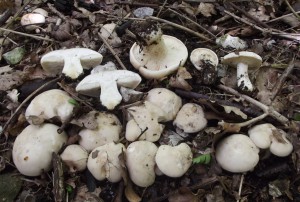17/05/2013
Calocybe Gambosa, or St George’s Mushrooms, are one of the few edible fungi that always appear in the spring. The name comes from their uncanny habit of appearing on St George’s day (April 23rd). They were one day late this year, although I have not seen a large quantity of pickable size until today. This is normal – they start to appear around St George’s day (rather unusual for them to be early) and then continue to grow for several weeks, finally disappearing with the first really hot weather.
They are saprophytic, and grow in a wide variety of habitats (woodland and grassland, by paths, and also in gardens and cemeteries), often in rings. They are very likely to be growing somewhere near you, right now.
They are reasonably safe for beginners to pick. If they grew in the autumn they wouldn’t be, because they are white-gilled mushrooms, and any mushroom which appears in summer/autumn and has gills that stay white should be treated with major caution by foragers because of the possibility of confusion with the deadly amanitas (in this case the destroying angel and the white form of the death cap). Those deadly amanitas don’t appear in the spring, so St George’s mushrooms aren’t usually confused with them, and there’s nothing else dangerous that looks like these, appear in the spring, and smell like these. The smell is a dead give-away – once you know the smell then there is nothing you could mix them up with, and even for somebody who has never found them before, it helps to know you are looking for something with a strong and distinctive odour.
Few wild mushrooms provoke as much disagreement over palatability as these. They are the fungal equivalent of marmite; some people love them, others hate them. There is also a wide range of opinion of how best the taste should be described (bonemeal, bread dough, melons…) Because of their strong taste, it is inadvisable to just use them as substitutes for normal mushrooms in recipes. They are traditionally served with liver, but will work just as well served on their own, fried in butter, with just about anything. What they don’t do is combine with other flavours as you’d expect normal mushrooms to do, so be experimental, but don’t assume that everything you try with them will work!
Happy hunting,
Geoff


That has got to be the clearest description of the taste/smell of these that I have yet read 🙂
I sometimes wonder if fungi vary the way that trees do. An apple is an apple, but they’re all different, so are elders, so are acorns. I can’t see why fungi wouldn’t be too. Maybe that accounts for the differing descriptions ?
kind regards,
MC
Hi Mary,
Maybe there’s some element of that, but I suspect it is also a case of people expecting a new food to taste/smell like some other food. Why should this be so? Why can’t it be distinct from everything else? It’s the same with common hogweed, which is also about at the moment. It smells/takes like….hogweed!!! 😀
The answer may come down to the infinite variety of organic molecules- we have a limited number of taste/smell receptors, but those receptors can encounter an unlimited number of configurations of carbon-based molecules in natural foods.
I might also add that having given up smoking a couple of months ago, I’m currently experiencing a whole new world of smells, including those of mushrooms! Although in this case the smell is so strong and distinctive that even a hardened smoker can detect it.
Geoff